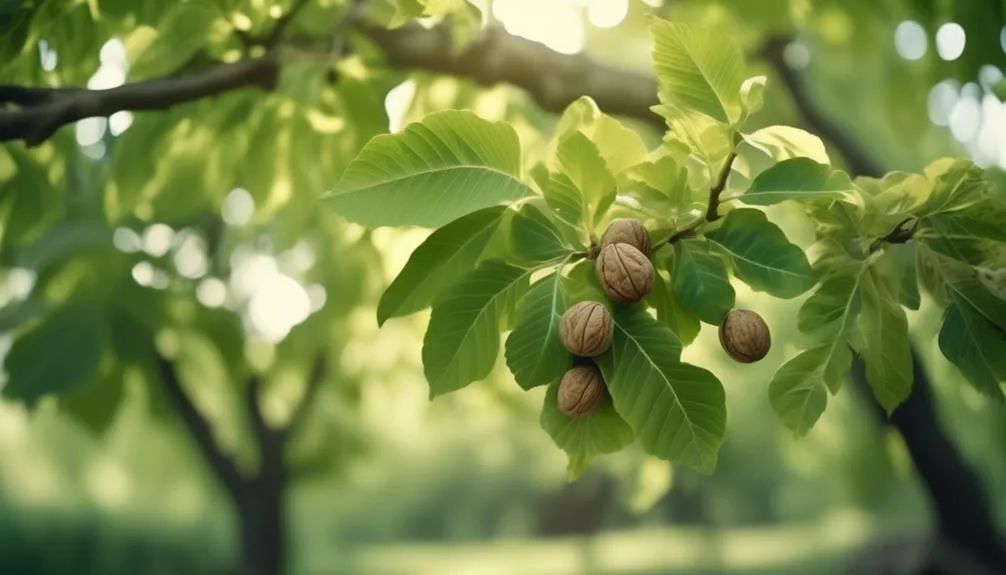If you've noticed strange spots on your walnut tree leaves or wilting branches, don't worry. Common walnut tree diseases like fungal infections and bacterial blights can affect your tree, but there are ways to deal with them.
It's important to know how to spot and treat these diseases to keep your walnut tree healthy. Let's look at some simple solutions to tackle these issues and keep your walnut tree in good shape.
Key Takeaways
- Regular inspection and monitoring of walnut trees is essential for early detection and effective management of diseases.
- Proper spacing between trees, pruning infected branches, and avoiding overhead irrigation can help prevent fungal diseases.
- Adequate moisture levels, removal of infected branches, and sanitation practices are important in preventing bacterial infections.
- Selecting disease-resistant cultivars, regular inspection, sanitation measures, and controlling insect vectors are crucial in preventing viral diseases in walnut trees.
Identifying Walnut Tree Diseases
To identify walnut tree diseases, it's important to closely inspect the leaves, branches, and trunk for any signs of discoloration, lesions, or unusual growth patterns. Regular tree inspection is crucial for early detection and effective disease management.
Start by examining the leaves for spots, wilting, or abnormal yellowing. Check the branches for any dark, sunken areas or cankers. Inspect the trunk for oozing sap, cracks, or unusual bumps. Keep an eye out for pests like aphids or mites, as they can contribute to disease development.
Fungal Diseases in Walnut Trees
Fungal diseases can significantly impact the health and productivity of your walnut trees, necessitating prompt detection and appropriate treatment. Preventative measures play a crucial role in managing fungal diseases in walnut trees. To minimize the risk, ensure proper spacing between trees for good air circulation, and prune to remove infected branches.
Additionally, avoid overhead irrigation to reduce moisture on the foliage, which can contribute to fungal growth. When it comes to treatment options, using fungicides at the first sign of infection can help control the spread of the disease. Look for fungicides specifically formulated for walnut trees and follow the application instructions carefully.
Regular monitoring and maintenance, along with timely intervention, can help protect your walnut trees from the detrimental effects of fungal diseases.
Bacterial Infections in Walnut Trees
As you work to protect your walnut trees from the impact of fungal diseases, it's important to also be vigilant for bacterial infections that can pose a threat to their health and productivity. Preventing bacterial infections in walnut trees requires implementing proper care techniques. Here are some essential measures to help you maintain the health of your walnut trees:
| Prevention Tips | Description |
|---|---|
| Proper Watering | Ensure adequate but not excessive moisture levels. |
| Pruning | Remove infected branches to prevent spread. |
| Sanitation | Keep the area around the trees free of debris. |
| Integrated Pest Management | Implement strategies to control insect vectors. |
Viral Diseases in Walnut Trees
When addressing viral diseases in walnut trees, it's crucial to be proactive in implementing preventative measures to safeguard their health and productivity. Preventing the spread of viral diseases is essential for maintaining the overall well-being of walnut trees.
To effectively manage viral diseases, start by selecting disease-resistant cultivars when planting new walnut trees. Additionally, regularly inspect the trees for any signs of viral infections, such as leaf discoloration, stunted growth, or unusual patterns on the bark. Proper sanitation practices, such as removing and destroying infected plant material, can help prevent the spread of viruses. It's also important to control insect vectors that may transmit viral diseases.
Treatment and Prevention
To effectively address the treatment and prevention of walnut tree diseases, it's crucial to integrate proactive measures into your tree care routine, ensuring the health and productivity of your walnut trees.
One essential aspect of prevention is preventing pests. Regularly inspect your walnut trees for signs of pests such as aphids, mites, or caterpillars. Applying horticultural oils or insecticidal soaps can help control these pests. Additionally, maintaining a clean and tidy garden by removing fallen leaves and other debris can discourage pest infestations.
Controlling blight is another key factor. To prevent blight, avoid overhead watering to minimize moisture on the leaves. Pruning and thinning the branches to improve air circulation can also reduce the risk of blight.
Implementing these preventative measures can significantly contribute to the overall health and disease resistance of your walnut trees.
Conclusion
Keep your walnut trees healthy and thriving by staying vigilant and addressing any issues promptly.
With proactive prevention and early treatment, you can look forward to a bountiful harvest of delicious walnuts for years to come.
Enjoy the beauty and benefits of a healthy walnut grove while ensuring the longevity of your trees.

